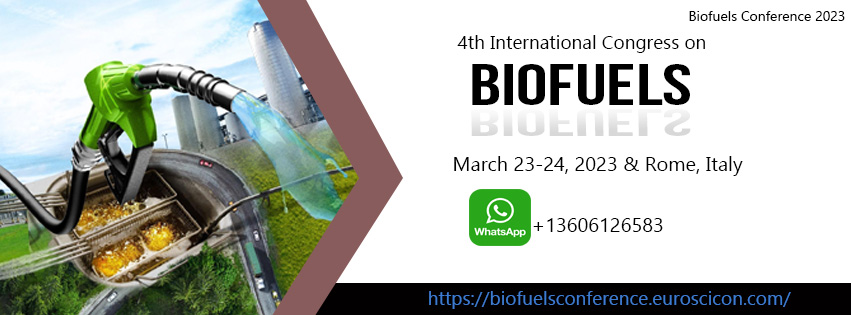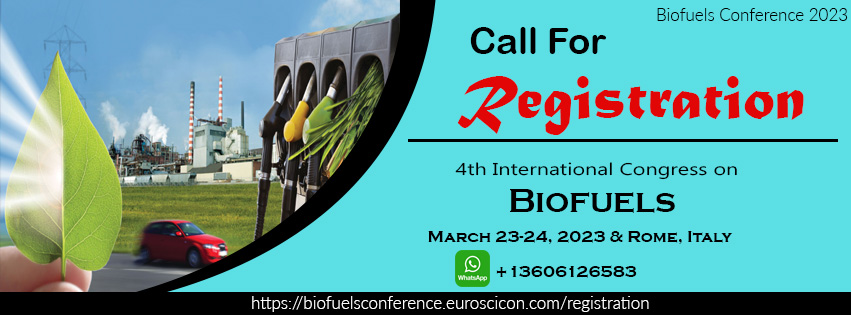biofuels-conf-2023
About Conference
On behalf of Organizing Committee, we would like to invite all the participants from all over the world to attend “4th International Congress on Biofuels” during March 23-24, 2023 in Budapest, Hungary. which includes prompt keynote presentations, Oral talks, Poster presentations, and Exhibitions.
Biofuels and Biorefinery
biofuel is a fuel that is produced through contemporary biological processes, such as agriculture and anaerobic digestion, rather than a fuel produced by geological processes such as those involved in the formation of fossil fuels, such as coal and petroleum, from prehistoric biological matter. Biofuels can be derived directly from plants, or indirectly from agricultural, commercial, domestic, and/or industrial wastes. Renewable biofuels generally involve contemporary carbon fixation, such as those that occur in plants or microalgae through the process of photosynthesis. Bioenergy is renewable energy made available from materials derived from biological sources. Biomass is any organic material which has stored sunlight in the form of chemical energy. As a fuel, it may include wood, wood waste, straw, manure, sugarcane, and many other by-products from a variety of agricultural processes.
Future & Scope:
Biorefinery and biofuels are recognized globally as crucial elements of the future energy matrix, without which the reduction in greenhouse gases needed to reduce the acceleration of global warming and climate change will not be achievable. Yet, in 2012 the oil-equivalent production of biofuels was less than 2% of the amount of oil produced from geological reserves.
The series Green Chemistry and Sustainable technology aim to present cutting-edge research and important advances in green chemistry. Green chemical engineering and sustainable industrial technology. Environmentally benign chemical synthesis and processes (green catalysis, green solvents, and reagents, atom-economy synthetic methods. Green chemicals and energy produced from renewable resources (biomass, carbon dioxide etc). Novel materials and technologies for energy production and storage (Bio-fuels and bioenergies hydrogen fuels cells solar cells lithium-ion batteries etc). Green technologies for environmental sustainability prevention, environmental redemption etc.)
The series Green Chemistry and sustainable technology are intended to provide an accessible reference resource for postgraduate students, academic researchers and industrial professionals who are interested in green chemistry and technologies for sustainable development.
Why attend?
14th International Conference on Biofuels and Biorefinery is exclusively designed for Biofuels Researchers, Bioenergy Scientists, Biofuels and Bioenergy organizations, Biofuels Professors, Bioenergy Doctors, and others engaged in endeavors related to Biofuels and Bioenergy research and business.
Target Audience:
Biofuels Conference 2023 is expecting the participants from all over the globe in various fields. This combination of the audience will give an ideal blend to justify our theme “Securing the World's future energy needs”
Biofuels & Bioenergy-2023 expecting attendees from
- Fuel Engineers
- Chemical Engineers
- Professors, Researchers, Students and Technical Staff from the field of Chemical Engineering
- Engineers and Delegates from Aviation and Automobile companies
- Directors/Co-Directors of Research-based companies across Europe and the US who are investing in Biofuels and Bioenergy
Session and Tracks
SESSION AND TRACKS
Track 1: Advanced Biofuels
Advanced biofuels are fuels that can be processed from various types of biomass. First generation of biofuels is processed from the sugars and vegetable oils formed in used crops, which can be smoothly extracted applying conventional technology. In comparison, advanced biofuels are made from lignocellulose biomass or woody crops, agricultural residues or waste, which makes it tougher to extract the requisite fuel. Advanced biofuel technologies have been devised because first generation biofuels manufacture has major limitations. First generation of biofuel processes are convenient but restrained in most cases: there is a limit above which they cannot yield enough biofuel without forbidding food supplies and biodiversity. Many first generation biofuels rely on subsidies and are not cost competitive with prove more powerful fossil fuels such as oil, and some of them yield only limited greenhouse gas emissions savings. When considering the production and discharge of something, especially gas or radiation transport, life-cycle assessment from first generation biofuels usually approach those of traditional fossil fuels. Advanced biofuels can aid resolving these complications and can impart a greater proportion of global fuel supply affordably, sustainably and with larger environmental interests.
Track 2: Aviation Biofuels
Aviation biofuel is a biofuel utilized for aircraft. It is reckoned by some to be the paramount means by which the aviation industry can diminish its carbon footprint. After a multi-year technical analysis from aircraft maker’s engine manufacturers and oil companies, biofuels were advocated for commercial use in July 2011. Since then, some airlines using with of biofuels on commercial flights. The limelight of the industry has now curved to advanced sustainable biofuels (second generation sustainable aviation fuels) that do not compete with food supplies nor are major consumers of prime agricultural land or fresh water.
Track 3: Production of Biofuels
Now a days we are currently used liquid biofuels, which include ethanol produced from crops containing sugar and starch and biodiesel from oilseeds these are all referred to as first-generation biofuels. These fuels only used for portion of the energy potentially available in the biomass. Various techniques are currently developed to produce biofuels. However, it is definite when such technologies will enter production on a significant commercial scale. The production of Biofuels can be done from the Biomass, Biodiesel from Biomass, and Biochemical from Biomass and Biogas from Biomass
Track 4: Algae Biofuels
Algae fuel or algal biofuels are exchange to liquid fossil fuels that uses the algae as its source of energy-rich oils and also algae fuels are substitute to common biofuel sources, Such as corn and sugarcane. Various companies, association’, government agencies are sponsoring efforts to reduce the capital and operating costs and make algae fuel production commercially feasible. Like fossil fuels and algae fuel releases CO2 when burnt, but unlike fossil fuel, algae fuels and other biofuels only release CO2 recently withdrawn from the atmosphere via photosynthesis as the algae or plant grew. The energy crisis and the world food danger have sparked interest in alga culture (farming algae) for making biodiesel and other biofuels utilizing land unbefitting for agriculture. Among algal fuels' are attractive characteristics that they are can be cultivated with negligible impact on fresh water resources, It can be generated using saline and waste water have a high flash point and biodegradable and comparatively harmless to the environment if spilled. Algae cost is the more other than advanced biofuel crops due to high capital and operating costs, but are declared to generate between 10 and 100 times more fuel per unit area.
Culturing Algae
Track 5: Renewable Energy
Renewable energy is energy that is generated from natural processes that are continuously restored. This includes sunlight, geothermal heat, wind energy, tides, water and various forms of biomass. This energy cannot be completely used and is constantly renewed. Biomass, is a renewable organic matter, and can be include biological material derived from living, or recently living organisms, such as wood, waste, and alcohol fuels.
Track 6: Nanotechnology In Biofuels
The use of nanotechnology which combines the control of materials at the size of the nanometer to green intriguing standards is "Green nanotechnology". It is correspondingly close to the utilization of the results of nanotechnology to upgrade conformity. Keeping up and increase soil, water, and air aspect speak to the absolute most commanding difficulties encountering a worldwide society in the 21st century. Contagion from such assorted sources as an oil and synthetic spills, pesticide and fertilizer overflow, abandonment modern and mining locales and airborne smoggy and particulate issue from cars worsen the coincidence once a day. Identifying and treating existing contaminants and counteracting new contagion are among the difficulties. Utilization of Nano-materials in assorted fields, for example, enhance the creation and clarifying of energies and decrease of exoneration from cars, endurance stockpiling (batteries and Nano-empowered fuel cells), to give safe drinking water through the enhanced water treatment, desalination, Nano empowered protection and outline of Nano-materials for corruption distinguish and location.
Track 7: Biomass Technologies
Biomass is organic matter remove from living, or recently living organisms. Biomass can be used as a source of energy and it most often directs to plants or plant-based matter which are not used for food or feed and are precisely called lignocellulosic biomass. As an energy source biomass can be used directly via combustion to produce heat or secondarily after transforming it to numerous forms of biofuel. Conversion of biomass into biofuel can be attained by various methods which are mainly categorized into thermal, chemical, and biochemical methods.
Several technologies for converting to bioenergy are commercial today while others are being piloted in research and development. There are four types of conversion technologies currently available, each appropriate for specific biomass types and resulting in specific energy products such as Thermal Conversion, Thermochemical conversion, Biochemical conversion, Chemical conversion. The Biomass Technologies are including Liquid Biofuels from Biomass and Cellulosic Ethanol from Biomass.
Track 8: Biorefineries
A biorefinery is a center of melds biomass conversion processes and equipment to manufacture fuels, power, heat, and chemicals from biomass. The biorefinery concept is parallel to today's petroleum refinery, which makes various field of fuels and products from petroleum. Biorefining is the sustainable conversion of biomass products and bioenergy. By producing various products of biorefinery takes advantage of the various parts in biomass and their intermediates, therefore, maximizing the value acquired from the biomass feedstock. A Biorefineries are manufacture one or two several low-volume, but high-value, chemical or nutraceutical products, and a low-value, but high-volume liquid transportation fuel such as biodiesel. At the same time generating the electricity and process heat, by combined heat and power (CHP) technology, for its own use and perhaps adequate for the sale of electricity to the local utility. The high-value products boost profitability, the high-volume fuel helps meet energy needs, and the power production aids to lower energy costs and minimize greenhouse gas emissions from conventional power plant facilities. Although some facilities prevail that can be called bio-refineries, the bio-refinery has yet to be fully accomplished. Future biorefineries may play a main role in yielding chemicals and materials that are traditionally extracted from petroleum.
Track 9: Bioalcohols and Bioethanol
Bioalcohols are synthesized alcohols, most frequently ethanol and rarely propanol and butanol, are formed by the reaction of microorganisms and enzymes through the fermentation of sugars or starches, or cellulose. Biobutanol (also called as a bio gasoline) is often asserted to provide a direct stand-in for gasoline because it can be used precisely in a gasoline engine. Ethanol fuel is the most frequently used biofuel worldwide. Alcohol fuels are formed by the fermentation of sugars derived from wheat, sugar beets, corn, molasses, sugar cane and any sugar or starch from which alcoholic liquors such as whiskey, can be produced (such as potato, fruit waste etc.). The ethanol manufacturing methods are applied to enzyme digestion (to release sugars from stored starches), distillation, fermentation of the sugars and drying. Ethanol can be used as petrol engines as a substitute for gasoline; it can be blended with gasoline to any concentration. Current car petrol engines can operate on mixes of up with 15% bioethanol along with petroleum/gasoline. Ethanol has lesser energy density than that of gasoline; this implies that it takes more fuel generate the same amount of work. An asset of ethanol its higher octane rating than ethanol free gasoline accessible at roadside gas stations, which permits the rise of an engine's compression ratio for increased thermal efficiency. In high-altitude locations, some states direct a mix of gasoline and ethanol as a winter oxidizer to lower atmospheric pollution emissions.
Track 10: Biopower Generation Techniques
Power Engineering is an Energy Engineering and Electrical Engineering that preparations with the generation, conveyance, distribution ann usage of electric force and the electrical apparatus associated with such frameworks including alternator, engines, and transformers. However a great part of the field is concerned with the issues of the three phase AC power the standard for acceptable scale power generation, transmission, and promulgation over the cutting edge world a clearly visible division of the field is concern about the change between AC and DC power and the improvement of particular power systems, for example, those used in aircraft or electric railway networks. The Power Systems were getting high productive with taking a break and have turned into a center region of the Electrical Engineering field.
Track 11: Biogas
Biogas commonly refers to a mixture of various gases formed by the decay of organic matter in the absence of oxygen. Biogas can be making from raw matters such as agricultural waste, municipal waste, manure, plant material, green waste, and sewage or food waste. Biogas is a renewable energy source and in diverse cases exerts a limited carbon footprint. Biogas can be make by fermentation of biodegradable materials or anaerobic digestion with anaerobic organisms, which disintegrates material inside an isolated system. Biogas is basically methane (CH4) and carbon dioxide (CO2) and may have small traces of hydrogen sulfide (H2S), siloxanes and moisture. The gases methane, carbon monoxide (CO) and hydrogen can be combusted or oxidized with oxygen. This energy yield allows biogas to be receiving an advantage as a fuel; it can be utilized for any heating purpose, such as cooking. It can also be performed in a gas engine to transform the energy in the gas to electricity and heat.
Track 12: Biodiesel
Biodiesel show an animal fat-based or vegetable oil diesel fuel comprising of long-chain alkyl (methyl, ethyl, or propyl) esters. Biodiesel is usually. It will made by chemically reacting lipids (e.g., soybean oil, vegetable oil, animal fat (tallow)) with alcohol generating fatty acid esters. Biodiesel is suggested to be used in standard diesel engines and is thus well-defined from the vegetable and waste oils used to operate fuel converted diesel engines. Biodiesel can be used separately or blended with petrodiesel in any proportions. Biodiesel mix with another substance can also be utilized as heating oil.
Track 13: Green Energy and Economy
Green energy mainly associates with natural energetic processes which will be disciplined with very little pollution. Anaerobic assimilation, geothermic power, wind power, small-scale hydropower, solar power, biomass power, periodic event power, wave power, and a few styles of atomic power belongs to the green energy. The green economy can be displaying resolve as an economy that aims at condensing environmental risks and ecological scarcities, which aims for estate development while not derogatory the atmosphere in keeping with the United Nations setting programmer. It firmly associated with environmental relating science, however, contains a great deal of politically connected core interest. A green economy is thought of together that is low carbon, asset reactionary and socially far-reaching. It dynamically correlates with biological pecuniary science, however, contains an appreciable measure of politically connected core interest.
Market Analysis
Strategies for developing the biofuels market:
The current phase of development of biofuels is driven by governments which have recognized the triple challenges of climate change, energy security and rural development. The significance of this phase, compared to the rapid phase of development of ethanol in Brazil in the 1970s, is that the issues are now global. Incentives or mandates for biofuels are being developed across the world from Europe to New Zealand, as well as in China, Southern Africa and Indonesia for instance. Different players in the biofuels industry are likely to have many strategies. We can imagine two fundamental strategic options: “watch and wait” which reacts to the mandates for biofuels; or “drive the market” where investments are made to enable taking a better competitive position in a growing industry. BP has not adopted the “watch and wait” strategy; instead we want to ensure our business meets the changing needs of our customers and stakeholders – be they motorists at the pump or government partners with whom we work to develop oil businesses. The demand for biofuels is not just a desire of policy makers, but is reflected in surveys of the general public – the consumer. Of the Europeans surveyed, 47% say they would be prepared to pay more for a vehicle that ran on biofuels, and 41% would be prepared to pay a little more for biofuels. BP’s strategy has involved the formation of a dedicated business unit to pursue opportunities across the value chain from accessing feedstock, through conversion to trading and marketing.

Fig 3: Demand of Biofuels
As the only direct substitute for fossil fuels, biofuels continue to grow in importance, despite a significant slowdown in investment. International trade remains active, with dynamic growth from the major exporting countries. However, current production technologies will very soon come up against the limits of resource availability, raising important questions regarding the ability to meet incorporation targets for 2021, especially in Europe and the USA. Current markets are therefore expected to maintain their current levels whilst waiting for the emergence of new biofuel technologies from 2015 onwards. The USA has been the world’s leading producer and consumer of biofuels since 2007. Then come South America and Europe, with slightly lower consumption levels, but with a strong predominance of biodiesel in Europe and ethanol in Brazil. After a significant slowdown in growth between 2008 and 2009, consumption of biofuels worldwide returned to growth in Although the European Union shows relatively stable consumption of biodiesel, South America has seen its consumption double, whilst that of the USA has fallen by nearly 50%. Ethanol consumption is growing at 20% in Europe and North America, whilst the situation remains stable or possibly declines slightly in South America.
Related Associations and Universities
Strategies for developing the biofuels market:
The current phase of development of biofuels is driven by governments which have recognized the triple challenges of climate change, energy security and rural development. The significance of this phase, compared to the rapid phase of development of ethanol in Brazil in the 1970s, is that the issues are now global. Incentives or mandates for biofuels are being developed across the world from Europe to New Zealand, as well as in China, Southern Africa and Indonesia for instance. Different players in the biofuels industry are likely to have many strategies. We can imagine two fundamental strategic options: “watch and wait” which reacts to the mandates for biofuels; or “drive the market” where investments are made to enable taking a better competitive position in a growing industry. BP has not adopted the “watch and wait” strategy; instead we want to ensure our business meets the changing needs of our customers and stakeholders – be they motorists at the pump or government partners with whom we work to develop oil businesses. The demand for biofuels is not just a desire of policy makers, but is reflected in surveys of the general public – the consumer. Of the Europeans surveyed, 47% say they would be prepared to pay more for a vehicle that ran on biofuels, and 41% would be prepared to pay a little more for biofuels. BP’s strategy has involved the formation of a dedicated business unit to pursue opportunities across the value chain from accessing feedstock, through conversion to trading and marketing.

Fig 2: Biofuels Production and Research

Fig 3: Demand of Biofuels
As the only direct substitute for fossil fuels, biofuels continue to grow in importance, despite a significant slowdown in investment. International trade remains active, with dynamic growth from the major exporting countries. However, current production technologies will very soon come up against the limits of resource availability, raising important questions regarding the ability to meet incorporation targets for 2021, especially in Europe and the USA. Current markets are therefore expected to maintain their current levels whilst waiting for the emergence of new biofuel technologies from 2015 onwards. The USA has been the world’s leading producer and consumer of biofuels since 2007. Then come South America and Europe, with slightly lower consumption levels, but with a strong predominance of biodiesel in Europe and ethanol in Brazil. After a significant slowdown in growth between 2008 and 2009, consumption of biofuels worldwide returned to growth in Although the European Union shows relatively stable consumption of biodiesel, South America has seen its consumption double, whilst that of the USA has fallen by nearly 50%. Ethanol consumption is growing at 20% in Europe and North America, whilst the situation remains stable or possibly declines slightly in South America.


































